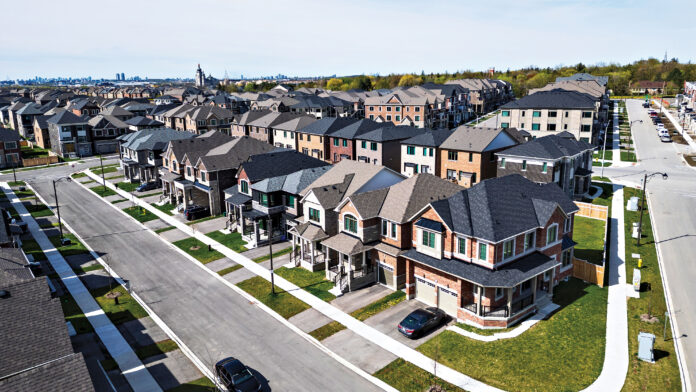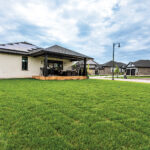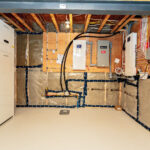By Natasha Rombough, Director of Marketing and Communications, CHBA
Just over 10 years ago, CHBA established a Net Zero Council (NZC) to guide the association’s efforts in high-performance housing. Leading members from across Canada came together with their specialized knowledge and unique perspectives to advance the voluntary adoption of Net Zero Homes.
The first NZC meeting took place in late 2014. Interest was strong among those who were passionate about building a better future and reestablishing Canada as a global leader in housing, and the inaugural meeting comprised of 50 voting members. Over the years, the council has continued to grow and now has 65 voting seats and seven ex-officio member organizations. Members are selected for their demonstrated competence and experience in Net Zero, R-2000 or Energy Star housing, and in specialized areas important to the advancement of Net Zero Housing, such as renovations.
The growth of CHBA’s Net Zero Home Labelling Program
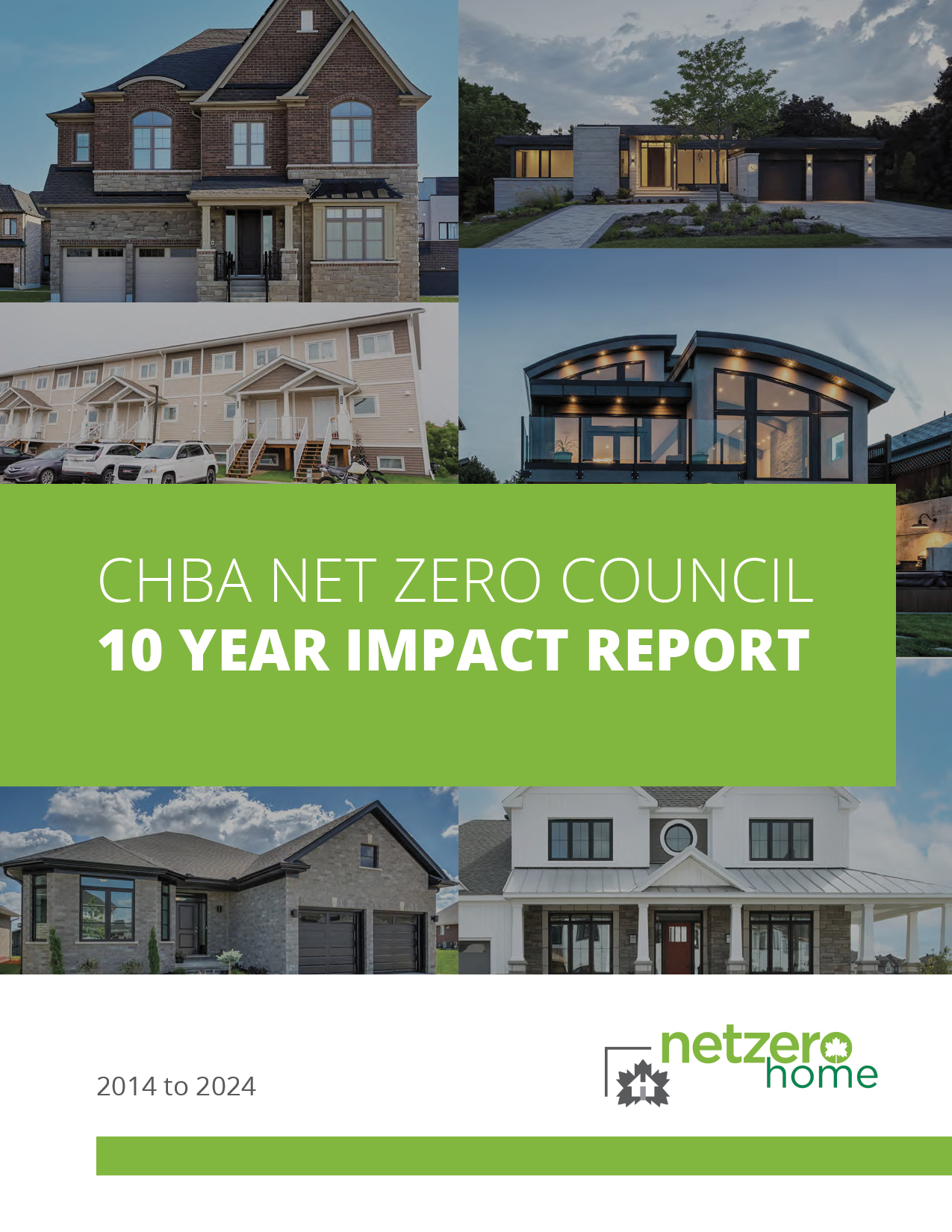
To support CHBA members’ voluntary adoption of Net Zero Housing, the Council’s first key priority was developing a labelling program. Supported by members and staff from across the country, rigorous two-tiered technical requirements were developed to recognize Net Zero and Net Zero Ready Homes, and the builders and renovators who provide them. The newly created Net Zero Home Labelling Program was piloted in 2015-16 with detached and attached single-family homes, and has since expanded to include lowrise multi-unit residential buildings and renovations.
The number of homes labelled is growing significantly each year as the program gains traction. From the official launch of the first version of program in 2017 to August 2022, 1,000 homes were labelled. Just two years later in August 2024, an additional 1,000 homes were labelled.
And only one year after that, the number grew by another 1,300 homes, bringing the total in August 2025 to more than 3,300 homes labelled.
The success of this industry-leading program comes from the dedication of members (most notably the NZC Management Committee members) and staff in staying focused on the goals of the program. From educating both the industry and homeowners/homebuyers on the benefits of Net Zero Homes, to providing program participants – builders, renovators, energy advisors, trainers and service organizations – with education and marketing support, the program’s success is multi-faceted.
Sonja Winkelmann, CHBA’s senior director of Net Zero Housing, was brought on board in 2014 to lead the development and delivery of services that support members’ voluntary adoption of Net Zero Housing. Passionate about making the world a better place and gifted at bringing together like-minded people, from her perspective, the biggest factor moving the needle is people working collaboratively and learning from each other.
“The peer-to-peer information and knowledge sharing has proven to be the key to success for the Net Zero Home Labelling Program to be an effective and scalable voluntary solution for the industry,” says Winkelmann.
Builders leading the way
At the time of writing, five CHBA Qualified Net Zero Builders reached the impressive milestone of labelling more than 100 homes through CHBA’s Net Zero Home Labelling Program: Activa, Avalon Master Builder, Doug Tarry Homes, Mattamy Homes and Sifton Properties Ltd. (You can find our Net Zero Builder/Renovator directory at netzerohome.com.)
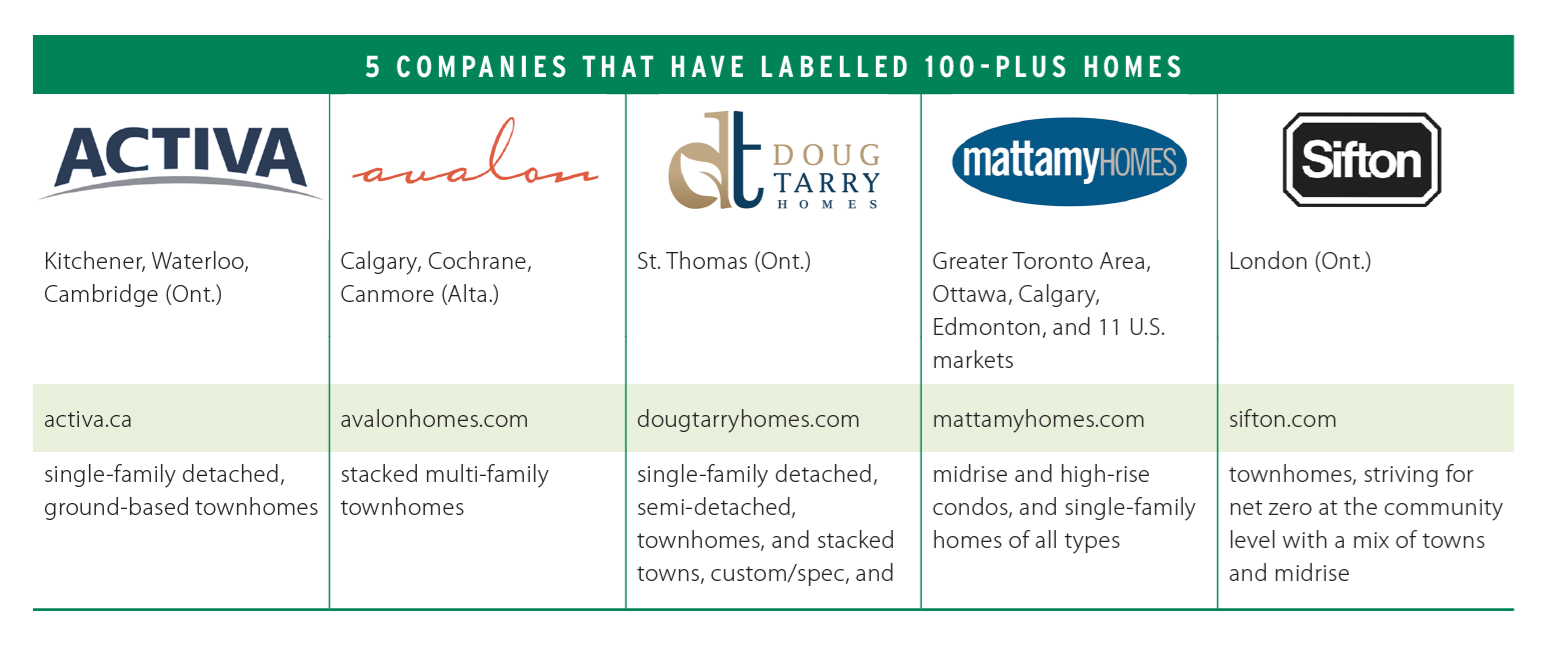
These companies made the decision to offer CHBA Net Zero and Net Zero Ready Homes to their clients because they believe in innovation and sustainability. To be successful using this competitive advantage, they’ve had to figure out how to build and sell Net Zero/Ready homes at scale. Through the process of doing so, they’ve learned a lot and honed their business models. We interviewed each of them, asking about the homes they build and how they communicate the value of them to potential buyers, the challenges they’re seeing, and if/how standardization has impacted their construction quality and timelines.
The importance of training sales and marketing staff
Sales and marketing teams need to know what makes CHBA Net Zero and Net Zero Ready Homes different, and how to communicate the homes’ value in a way that resonates with buyers. Each builder approaches that objective in their own way, but one piece of advice came up several times: Training should be ongoing, “not a one-and-done session,” as Mattamy puts it. One of the most important parts of their training is helping their customer-facing teams translate the technical jargon into everyday language that homeowners can easily understand. In the company’s words: “We want people to see not just the specs, but the real-life benefits.”
At Avalon, in addition to all sales team members completing CHBA’s Net Zero Builder Training, the company provides ongoing learning materials and keep staff updated on the latest news and developments, and they tour their under-construction homes when key elements to Net Zero are being installed. As a result of these ongoing actions, the sales team “can confidently explain how CHBA Net Zero and Net Zero Ready Homes save money, promote healthier living and reduce environmental impact – making it easy for customers to see true value.”
Activa ensures its teams have access to training, so they learn “how to shift the conversation from technical details to what really matters to homeowners – the comfort of a consistent temperature, the health benefits of cleaner indoor air and the peace of mind that comes with a home designed to perform at a higher level.”
Doug Tarry is a big proponent of training and even wrote a builders’ guide to Net Zero Homes, which its sales staff receives in addition to in-person bootcamp training and ongoing interdepartmental training on what other departments do.
At Sifton, the company’s focus is on making sure sales staff understand the features and long-term benefits of CHBA Net Zero Homes, including their future-proof value.
Challenges the builders are seeing and how they’re tackling them
Several of the companies mentioned the current economy as one of their biggest hurdles, especially given the additional cost to build a Net Zero/Ready Home. About two years ago, Doug Tarry Homes pivoted on its inventory to get to a product they felt customers would be able to afford. This included looking at its land inventory and, in one instance, re-lotting a registered plan. “It’s not for the faint of heart, but it is working,” according to the company. “We are hitting our targets and maintaining our margins by offering responsible pricing for a quality product.”
Activa is doing what it can to mitigate the impact of tariffs, and by working closely with trade partners, the company has proactively identified accepted alternatives to mitigate cost impact and address potential product shortages.
Sifton says its biggest challenge is balancing consumer preferences for cosmetic upgrades with the technical investments needed to achieve a CHBA Net Zero/Ready labelled home. The company also says “evolving regulations around large-scale solar generation are driving up costs. To support Ontario’s clean energy goals, we need smart, scalable policies that enable innovation without placing the burden on homeowners.”
In the multi-family space, one of Avalon’s big challenges is limited roof space, making it difficult to install enough solar panels to bring each home in a building to Net Zero. With help from the new “Alternative Compliance Path,” the company can achieve Net Zero Ready, though, and it hopes that advancing technologies will soon allow them to get to Net Zero.
For those looking to make the jump to Net Zero/Ready, Mattamy confirms that change itself is always a big hurdle. Its advice? “Architecture, sales, construction, warranty – everyone has to be on the same page about what’s changing and why. Then it’s about giving them the tools, training and ongoing support to make it work in practice.”
How standardization improves consistency in construction quality
Activa has standardized many of its Net Zero Ready measures, including the building envelope and high-performance windows, to ensure consistency across every home it builds. “This approach has allowed our trades to become highly skilled and efficient in meeting these requirements, completing their work quickly without compromising quality. The result is a streamlined building process that delivers reliable performance.”
Mattamy says standardization is key when building at scale. “We focus on performance-based standards; for example, we set consistent performance requirements for windows rather than locking into one exact model. That gives us flexibility with suppliers, helps our trades work more efficiently, and still ensures the quality homeowners expect.”
For builders considering offering Net Zero/Ready Homes, Doug Tarry Homes recommends “leaning” out your building processes (find the wasted money in your materials and processes) and then offering it as your standard. The company offers sub-slab insulation that doubles as a radon soil gas barrier, wind resilient roofs, triple-glazed low solar glass windows with a warm edge spacer and flange extension, AeroBarrier for every unit and Graphenstone Paints as standard in their Net Zero Ready offering, among other things.
Sifton has standardized its windows from a performance standpoint, HVAC systems (right-sized for the units), insulation values and exterior wall configurations. Doing so has assisted in better trade processes and quality within the finished homes. The company made sure to point out that standardization alone isn’t enough: “Education and training of these processes and expectations is an ongoing effort.”
The future of Net Zero
Learning from companies that successfully build CHBA Net Zero Homes at scale will always be a cornerstone of growing the Net Zero Home Labelling Program. And there is plenty of room to grow.
Within the next few years, the NZC’s goals include expanding the labelling program to include an option for operational and embodied emissions reductions. Unquestionably, the single largest business opportunity is in Canada’s existing housing stock, where the most operational GHG emissions reductions can be made. Which is why the CHBA Net Zero staff are working on producing a Net Zero Reno Roadmap (a guide for getting homes to net zero in stages) and Renovator Option Packages (ROPs). As more renovators become qualified under the program, having a network of Qualified Net Zero Renovators across the country who are renovating homes to Net Zero/Ready levels of performance, it will build homeowner market confidence.
To see true success in the market, we know we have to build high-performance homes faster, better and more affordably. The NZC’s big goal is getting the industry to the point where it can build to Net Zero or Net Zero Ready for zero additional total cost of ownership compared to a Tier 1 2023 home.
To do so, the NZC is focused on applied research, development and demonstration (RD&D) initiatives, working with industry leaders to identify and prioritize barriers and seek innovative solutions for cost-effective Net Zero levels of performance, focused on both energy efficiency and emissions reductions, for all housing forms. It’s a huge undertaking, and involves cross-pollination with many groups, including CHBA’s Technical Research Committee and joint work in Climate Change Mitigation, Adaptation and Resilience guidelines and standards.
Industry education is also a key priority, and CHBA continues to produce practical training under the Net Zero umbrella. Earlier this year, CHBA released two new self-directed courses that allow learners to complete the material at their own pace: The Advanced Building Science Course and the Net Zero for Building Officials Course. Coming soon are five more e-learning courses, including the “revamped” sales training course now called “The Net Zero Market Advantage,” which explains the value of Net Zero Homes and how to talk about it with potential buyers in a way that resonates with their own values and priorities.
“With insight and direction from our members, we’re dedicated to supporting the industry to make Net Zero and Net Zero Ready Homes an affordable choice for Canadians,” Winkelmann sums up.







